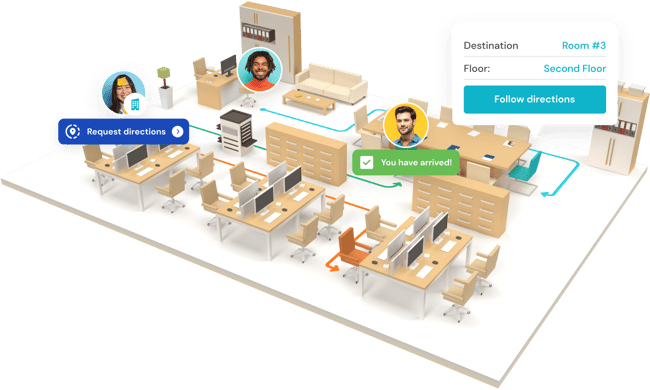The Great Return to Office Debate Is Over—Now It’s About Making It Work
Hybrid. Fully remote. Back to the office. Workplace conversations have been in flux for years, yet one thing is clear—there's no one-size-fits-all solution.
In the last few years, companies have experimented with every variation of work. Some leaned fully into remote flexibility, while others called employees back to the office in waves, adjusting policies along the way. But now, in 2025, we've moved past the era of knee-jerk reactions and hesitant trial runs.
The conversation is no longer about IF employees should return—it's about HOW to make the office work better so that people want to be there more often and are empowered to do their best work.
The office is here to stay, and in one form or another—whether through structured hybrid models or fully on-site work—return-to-office (RTO) will be a reality for the majority of companies.
Who This Guide Is For
Whether you're a business leader redefining workplace policies, an HR professional balancing employee needs, or a workplace strategist optimizing office spaces, this guide is for you.
We'll break down:
- The current state of return-to-office (RTO) efforts, backed by fresh data.
- The challenges companies are facing as they navigate hybrid and in-office work.
- Practical strategies for building a workplace that works for everyone—one that brings employees in more often without forcing it.
No fluff. No outdated hot takes. Just real insights on what's working, what's not, and where we go from here.
The State of RTO in 2025
Return-to-office is no longer an experiment—it’s a defining reality for most organizations. While the approaches vary, the trend is clear: companies are solidifying long-term workplace strategies that balance business needs with employee expectations.
In 2023 and 2024, we saw companies test different RTO strategies, from mandated office days to flexible hybrid models. Now, in 2025, those policies have taken shape:
Full RTO Mandates Are Rising, but (Structured) Hybrid Remains Dominant
33% of U.S. employers now require full-time office attendance, with this number expected to grow slightly in 2025 but not exceed 50%. However, hybrid work has become the prevailing model, with 38% of companies offering some form of hybrid structure.
This shift has led to the emergence of structured hybrid as the dominant flexible work model. At structured hybrid companies, employees aren’t required to be in the office full-time, but there are clear expectations—most commonly on a weekly basis—about how often they should be on-site.
.jpg?width=1000&height=564&name=flex%20index%20office%20requirements(1).jpg)
Source: Flex Index, Flex Report Q4 2024
Three Days In: The 2025 Standard for Hybrid Work
If there’s one number that keeps coming up in hybrid policies, it’s three. Among companies embracing a hybrid model, the most common arrangement requires employees to be in the office three days per week—a structure that’s becoming the default for balancing flexibility with in-person collaboration.

Source: Resume Templates
Office Occupancy Rates Have Rebounded
Office occupancy rates have been gradually improving. In the last week of February 2025, the US national average occupancy rate reached 55.13%, marking a post-pandemic high. This increase is influenced by various factors, including return-to-office mandates from both private employers and government entities.
Different Industries, Different RTO Playbooks—But Structure Is Key
Industries are taking distinct approaches to return-to-office policies, shaped by their operational needs and workplace cultures.
Finance and consulting firms are leading the charge with strict in-office mandates—JPMorgan Chase recently announced that hybrid employees must return five days a week, reinforcing its emphasis on in-person collaboration, while Goldman Sachs has maintained a full-time office requirement, signaling a return to pre-pandemic norms.
Tech companies are tightening their hybrid policies as well—Amazon increased its on-site requirement from three to five days per week in 2025, citing the benefits of in-person innovation, and Apple now expects employees in the office four or more days a week to sustain its collaborative culture.
"When we look back over the last five years, we continue to believe that the advantages of being together in the office are significant. <...> it’s easier for our teammates to learn, model, practice, and strengthen our culture; collaborating, brainstorming, and inventing are simpler and more effective; teaching and learning from one another are more seamless; and, teams tend to be better connected to one another."
💬 Andy Jassy, CEO of Amazon
On the other hand, retail and consumer brands are leaning into structured hybrid models. Woolworths has formalized a three-day in-office policy, aiming to balance flexibility with operational efficiency.
Across industries, the message is clear: while approaches vary, companies define clear expectations, moving away from flexible-for-the-sake-of-flexibility and toward structured, intentional workplace strategies.
The Ripple Effect of Corporate and Government RTO Mandates
When industry leaders make a move, others follow. Major corporations setting firm return-to-office policies aren’t just making headlines—they’re influencing workplace decisions across the board.
54% of companies report that they have been at least somewhat influenced by big-name organizations requiring in-office work. The trend doesn’t stop at the private sector—35% of companies say the federal government’s executive order to bring employees back has also shaped their approach.
The Business Impact of RTO: Costs, Threats & Benefits
As companies navigate the return-to-office transition, the financial and operational implications become more apparent. From rising overhead costs to proximity bias, businesses must weigh the risks against potential benefits.
Why Some Companies Are Pushing for a Full Return to the Office
For companies requiring employees to be in the office full-time, the reasoning is simple: they believe in-person work leads to stronger collaboration, higher productivity, clearer communication, and easier team management. Many also see it as essential for maintaining company culture and ensuring alignment across teams.

Source: Resume Templates
But even among companies embracing structured flexibility, the logic behind in-office time is similar:
- Culture is built in person. Workplace culture isn’t just about values on a slide deck—daily interactions shape it: the casual check-ins, the quick problem-solving chats, and the moments of unplanned collaboration. Companies with structured hybrid models want to ensure those moments still happen regularly.
- Collaboration works better face-to-face. More communication doesn’t always mean better teamwork. Microsoft’s 2024 Work Trend Index found that remote employees send 42% more messages and attend 25% more meetings than their in-office peers—yet they still feel less connected. Many companies see in-person time as a way to reduce digital fatigue and improve the quality of collaboration.
- Learning and career growth happen faster in the office. A staggering 55% of employees say they develop new skills at a slower pace in a hybrid setup. Meanwhile, employees who are in the office more often have greater access to informal coaching, mentorship, and leadership visibility—factors that directly impact career progression.
- Innovation isn’t scheduled—it happens in the margins. Companies in tech, finance, and creative industries argue that their best ideas don’t come from planned brainstorming sessions but from unstructured, organic conversations. The quick back-and-forths that happen when people are in the same space are hard to replicate remotely, which is why structured hybrid models ensure teams have dedicated in-person time for deep collaboration.
The Risk of Proximity Bias
A staggering 96% of executives admit they notice in-office efforts more than remote work, revealing a clear proximity bias in how leadership recognizes contributions. The "seeing is believing" mindset remains deeply ingrained—when an in-office employee stays late to finish a project, their dedication is evident. Meanwhile, a remote worker putting in the same effort might go unnoticed.
“Let’s face it, putting in face time with the boss and working remotely foster two different sets of feelings for many managers: one employee is in the office working with me and I can see what they’re doing, and the other employee corresponds with me, but I don’t have as many conversations or as much oversight as I have with an in-person employee. This causes more of an emotional disparity.”
💬 Martin Gasparian, Owner/Attorney at Maison Law
The Cost of Office Space
The financial implications of Return to Office (RTO) are considerable and demand careful evaluation. One of the most significant costs is office space—maintaining a full office can run companies thousands of dollars per employee each year when you account for real estate, utilities, office supplies, and amenities. In contrast, companies that have adopted remote or hybrid models have enjoyed significant cost savings, often slashing overheads by reducing office space requirements and eliminating commuting-related expenses.
|
SUCCESS STORY €200,000 yearly savings on office space |

|
Like many companies worldwide, ASEE in Romania was forced to transition to remote work during the pandemic. With their office space largely unused during the pandemic, ASEE downsized their Bucharest headquarters, cutting one out of four floors from their lease.
Trasitioning to the hybrid work setup after pandemic, ASEE faced logistical challenges, particularly with ensuring proper office space usage while adhering to safety guidelines and legislative requirements. With their previous manual tracking systems falling short, the company turned to YAROOMS, a workplace management solution, to streamline scheduling and space booking.
The results were impressive: not only did the transition to hybrid work go smoothly, but ASEE also saved around €200k in a year—money that would have otherwise been spent on leasing and maintaining the extra floor.
ASEE is a great example of how companies can return to office and cut costs with modern workplace technology.
However, if you’re considering a five-day workweek for everyone and your workforce is growing, the impact could be quite different. In this case, you should carefully evaluate potential new expenses, especially those related to office space.
Breaking Down the Financial RTO Impact for Employees
According to research, employees returning to the office face a significant financial burden, with daily costs adding up quickly. On average, workers will need to cover expenses like outfits ($12.60), beauty products ($2.75), childcare ($60), pet care ($22.50), and commuting ($32.56)—not to mention coffee, breakfast, lunch, snacks, and drinks. When combined, these costs can easily exceed $100 per day, making the return to the office far more expensive than working remotely.

Source: Crafty Delivers
While remote work comes with some costs (like home office supplies or increased utility bills), the daily expenses associated with in-office work—especially those related to commuting and caregiving—are hard to ignore.
This creates a clear challenge for employers: if you're mandating RTO, you need to recognize that your employees' financial well-being is directly tied to their willingness to return to the office. Childcare and commuting costs make up the biggest chunk of expenses for employees, and if these aren't addressed, workers may feel undervalued. To help alleviate these pressures, consider offering subsidized childcare and transportation benefits.
Hybrid Work Reduces Employee Attrition by One-Third, Study Shows
The reasoning behind RTO policies is consistent: companies want employees in the office because they believe it makes work better. But there’s another factor that leaders can’t ignore—employee preferences.
If you’re considering a full return to the office, the data suggests a gradual approach may be the smarter move. Why? Because giving employees some level of flexibility significantly reduces turnover.
A study by Trip.com tested this in real life. Over six months, they split 1,612 employees into two groups:
- One group worked full-time in the office
- The other followed a hybrid model with two remote days per week
The results were striking:
- Employees in the hybrid group were 33% less likely to quit than those required to be in the office full-time.
- The quit rate dropped from 7.2% to 4.8%, proving that even a tiny amount of flexibility impacts retention.
- Hybrid employees also reported higher job satisfaction, with an average rating of 8.19 out of 10, compared to 7.84 for the full-time office group.
According to the research, some groups benefit even more from hybrid models:
- Non-managers – Employees without leadership roles, who often have less negotiating power, showed significantly higher retention rates with hybrid options.
- Women – With more caregiving and household responsibilities, women reported stronger organizational commitment when given flexible work arrangements.
- Long-distance commuters – Employees with longer commutes showed higher job satisfaction and loyalty when allowed to work remotely part of the time.

Source: Trip.com
The experience of companies that adopted flexible work policies backs up this data: Yelp’s shift to remote work has led to a 13% decrease in turnover since 2021. Likewise, Spotify’s “Work From Anywhere” policy has helped reduce attrition by 15%.
Why Are Employees Resisting RTO?
For many employees, returning to the office isn’t just about the commute—it’s about autonomy, flexibility, and the ability to structure work in a way that fits their lives. The shift to remote work wasn’t just a logistical adjustment but a fundamental change in how people view work and productivity.
To some, remote work isn’t just about location—it’s about autonomy. When employees can shape their schedules around their most productive hours, they work more efficiently and effectively.
"Remote work allows our team to complete more work with more autonomy over our work hours. When we can structure our days how we want to and flex our time to suit our schedules, it’s easier to maintain high productivity levels when we find those quiet times to work."
💬 Jack Underwood, CEO & Co-Founder at Circuit
Flexible workers argue that when companies focus on results instead of attendance, they empower employees to take ownership of their work—leading to greater accountability and productivity.
"Employees want to be treated like adults, not schoolchildren, who must show up at a particular time and sit in their seats. When you instead focus on results, time and location become tools that employees use to get the work done. Autonomy paired with accountability."
💬 Melissa Hunsberger, Conversion Copywriter & Strategist at The Hunsberger Group
Finally, remote advocates strongly believe that without the social maneuvering that often comes with office life, they can focus on what truly matters—their work.
"Employees gravitate towards full remote work due to its ability to alleviate the stress associated with engaging in office politics. With remote work, individuals can focus on their tasks and deliverables, free from the distractions and power dynamics that can arise in traditional workplace settings. This allows for a more focused and results-driven work environment, where merit and individual contributions take precedence.”
💬 Normand Chevrette, President & CEO of CME Corp
RTO Strategy: 5 Essential Steps + Resources
Now that we have all the data and insights around Return to Office (RTO), it's time to create a clear and actionable plan. Here are the essential steps to guide your RTO strategy, along with additional resources for deeper insights at each stage.
1. Start with Transparency and Communication
To make RTO work, honesty is key. Employees must understand why RTO is happening and how it benefits them and the company. Communicate openly about the challenges you're trying to solve—whether it's enhancing collaboration, building a stronger company culture, or improving productivity. Give employees a seat at the table: involve them in shaping the policies and ask for feedback regularly.
💡 Further reading:
Give Your Employees a Role in Shaping Their Office Experience
Tap Into Employee Behavior Data for Optimal Hybrid Office Design
2. Offer Flexibility with Structure
Data shows that hybrid work is here to stay, but clarity is crucial. Three days in the office has become the standard, but ensure the structure supports your team's needs. Define which days are critical for in-person work and which are flexible, and be transparent about the reasoning behind these decisions. Giving employees flexibility while maintaining some structure strikes the right balance for productivity and satisfaction.
💡 Further reading:
Structured Hybrid Work: The Sweet Spot between In-Office and Remote?
The Hybrid Work Schedule Calendar: Making Flexibility Transparent
3. Address the Financial Burden of RTO
Returning to the office brings additional costs for employees—commuting, childcare, and daily expenses like meals and coffee. Consider offering benefits like subsidized transportation, childcare support, or office lunches to ease these financial pressures. Since commuting and childcare are the largest expenses, providing assistance in these areas can significantly raise employee buy-in for RTO.
💡 Further reading:
Hybrid Work as a Sought-After Solution for Working Parents
What Workplace Benefits Make Sense in Modern Workplaces?
4. Make Your Office Worth Coming Back To
If you want employees to return, create an office environment they enjoy. Think about redesigning your office to foster collaboration but also include quiet spaces for focused work. Incentives like free meals, flexible seating, or a stocked kitchen can make a huge difference. Make the office feel like a place that adds value to their day—not just a workspace they’re mandated to attend.
Learning and Knowledge Sharing: A Modern Incentive to Come to the Office
Boost Employee Morale by Streamlining Access to Workplace Resources
5. Measure and Adjust
Track how your RTO policies are performing. Use key metrics like attendance rates, employee satisfaction, and productivity to measure success. Employee surveys are essential to gauge feelings about RTO and gather insights on what's working and what needs tweaking. The goal is to create a continuous improvement cycle—don't be afraid to adjust based on real data.
💡 Further reading:
Hybrid Work Analytics – The Key to an Optimized Hybrid Workplace
Decision-Making in the Dark? Why Leaders Should Not Overlook Data in Return-to-Office Planning
Solving RTO Challenges with the Right Technology Tools
Now, let’s discuss some common challenges companies face as employees return to the office and how technology tools can help solve them, making the transition smoother and more efficient.
Space and Resource Booking
❗Challenge: Finding available desks or meeting rooms in a hybrid setup can feel like a game of chance. Employees waste time searching for space or dealing with overcrowded offices.
✅ Solution: Desk booking, meeting room reservations, and parking space management tools help employees secure their spot in advance, optimizing resource use and reducing frustration.

Hybrid Work Scheduling
❗Challenge: With some employees in the office and others remote, it’s hard to know who’s available, leading to missed collaboration opportunities.
✅ Solution: A hybrid work status calendar shows who’s in the office and who’s remote, making it easier to schedule meetings and improve coordination.

Visibility & Accessibility
❗Challenge: Managing work across multiple locations and schedules becomes a hassle when everything is confined to a desktop. Employees struggle to stay updated or find the right space when not physically at the office.
✅ Solution: Mobile access puts everything in the palm of your hand—employees can book spaces, view real-time schedules, and stay connected from anywhere, ensuring instant visibility and easy access for a smooth, on-the-go hybrid experience.

Lack of Insight into Employee Work Patterns and Office Space Utilization
❗Challenge: Companies often lack a clear understanding of how employees divide their time between remote and in-office work, leading to inefficient space usage and poor planning for team collaboration.
✅ Solution: Workplace analytics, gathered by advanced workplace management platforms like YAROOMS, can provide real-time data on employee work patterns and office space utilization. This helps companies track when employees are likely to be in the office and which areas are being used, enabling better space optimization and more effective scheduling for collaboration and resource allocation.

Difficulty Navigating the Office
❗Challenge: In hybrid work environments, employees often find it difficult to navigate the office, especially when spaces are constantly changing or not clearly marked.
✅ Solution: Wayfinding tools make it easy for employees to find available desks, meeting rooms, and other office resources. With interactive maps and real-time updates, employees can quickly locate where to go, saving time and reducing frustration. This makes the office experience smoother and more efficient, helping everyone use the space more effectively.

Organize a Smooth Return with YAROOMS Workplace Management Platform
Returning to the office doesn't have to feel complicated. YAROOMS Workplace Management Platform helps you simplify your hybrid setup, from easy space booking and interactive wayfinding to real-time visibility into who's working remotely or on-site. Plus, YAROOMS seamlessly integrates with Microsoft 365, Google Calendar, Zoom, and the other workplace tools your teams already know and love. That means employees spend less time managing logistics and more time doing their best work wherever they are.








